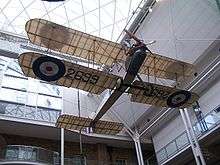Aircraft dope

Aircraft dope is a plasticised lacquer that is applied to fabric-covered aircraft (both full-size and flying models[1]). It tightens and stiffens fabric stretched over airframes, which renders them airtight and weatherproof.[2]
Typical doping agents include nitrocellulose, cellulose acetate and cellulose acetate butyrate. Liquid dopes are highly flammable; nitrocellulose, for instance, is also known as the explosive propellant "guncotton". Dopes often include colouring pigments to facilitate even application, and are available in a wide range of colors.
Dope has been applied to various aircraft fabrics, including madapolam,[3] but also more recently on polyester and other fabrics with similar fine weave and absorbent qualities.[4]
Accidents
Accidents have occurred when dope is not used correctly, for example when mixed with other chemicals, used on the wrong fabrics, or applied to contaminated or improperly prepared surfaces.
In the 1930 R101 disaster,[5] improper doping caused the fabric of the airship to become brittle and easily torn.
On 27 April 1995 91-year-old aircraft designer, builder and significant figure in the homebuilt aircraft movement, Steve Wittman and his wife were killed when their Wittman O&O Special broke up in flight due to delamination and separation of the wing fabric, resulting in wing aeroelastic flutter. The US National Transportation Safety Board investigation determined that the layers and types of doping they used did not have "the best adhesive qualities" and referred to "the Poly-Fiber Covering and Painting Manual" for proper processes to use.[6]
References
- ↑ Hertz, Louis Heilbroner (1967). Complete Book of Model Aircraft, Spacecraft and Rockets. Crown Publishers.
- ↑ Crane, Dale: Dictionary of Aeronautical Terms, third edition, page 170. Aviation Supplies & Academics, 1997. ISBN 1-56027-287-2
- ↑ Hickman, Kennedy (2012). "World War II: De Havilland Mosquito". About.com. Retrieved 6 January 2012.
- ↑ Wills, Philip (1966). British Gliding Association Handbook.
- ↑ Structures (or, Why Things Don't Fall Down), chapter 16: "A Chapter of accidents"; by J. E. Gordon, published 1978 by Penguin Books
- ↑ National Transportation Safety Board (December 1995). "Brief of Accident" (PDF). Archived from the original (PDF) on March 22, 2012. Retrieved 27 August 2011.